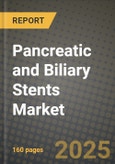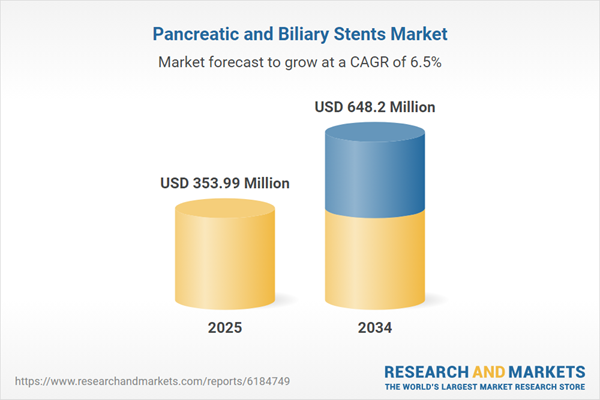Pancreatic and Biliary Stents Market
The Pancreatic & Biliary Stents Market addresses endoscopic, EUS-guided, and percutaneous drainage of malignant and benign obstructions in the common bile duct and pancreatic duct, spanning plastic stents (straight, pigtail) and self-expanding metal stents (SEMS) - uncovered, partially, and fully covered - as well as lumen-apposing metal stents (LAMS) for EUS-guided gallbladder drainage and pancreatic fluid collections. Value creation hinges on patency, migration resistance, controlled radial force, anti-reflux design, and deliverability through tortuous anatomy under fluoroscopic and ultrasound guidance. Oncology (cholangiocarcinoma, pancreatic, periampullary tumors) and post-operative strictures dominate indications, while chronic pancreatitis and benign biliary strictures sustain exchange-driven volumes. Trends include thinner, more trackable delivery systems for altered anatomy, hydrophilic/low-friction coatings, anti-biofilm surfaces, and stents tuned for ERCP vs EUS roles. Hospitals and advanced ASCs weigh upfront device cost against exchange frequency, anesthesia time, readmission risk, and quality-of-life endpoints; reimbursement pathways and day-care protocols influence site-of-care shift. Competitive dynamics pit global endoscopy majors and specialized innovators against regional value players, with stickiness driven by physician preference, proctorship programs, and accessory ecosystems (sphincterotomes, guidewires, dilation, cholangioscopy). As cancer care pathways emphasize faster biliary decompression and fewer re-interventions, procurement favors platforms with strong clinical evidence, predictable deployment, and comprehensive training and service.Pancreatic and Biliary Stents Market Key Insights
- Plastic vs. metal: economics, patency, and exchange strategy
- Covered, partially covered, and anti-migration design trade-offs
- EUS-guided interventions expand the addressable market
- Benign strictures demand planned, protocolized therapy
- Materials & coatings: pushing patency and visibility
- System-level kits and accessories create stickiness
- Cholangioscopy and imaging guide difficult anatomy
- Complication mitigation is a procurement criterion
- Reimbursement and site-of-care shifts influence portfolios
- Regulatory and quality systems shape vendor selection
Pancreatic and Biliary Stents Market Reginal Analysis
North America
High ERCP/EUS adoption and ASC growth favor easy-to-deploy SEMS and LAMS with reliable anti-migration features. Value analysis teams prioritize clinical evidence for reduced exchanges and complications. Integrated vendor training, on-call proctorship, and strong post-market data are key to system-wide standardization.Europe
Stringent MDR documentation and multidisciplinary tumor boards drive evidence-led selection. Preference leans toward covered/removable options for benign disease and long-patency SEMS for malignancy, with growing EUS use in centers of excellence. Hospitals value comprehensive accessory ecosystems, clear IFUs, and sustainability initiatives in reprocessing and packaging.Asia-Pacific
Large patient volumes and expanding endoscopy infrastructure accelerate uptake of cost-effective plastic stents and selected SEMS, with rapid growth in EUS-guided therapies at tertiary centers. Training partnerships and local service footprints are critical; vendors win with broad size ranges, trackable delivery systems, and multilingual support.Middle East & Africa
Referral centers expand ERCP programs, with gradual introduction of EUS-guided drainage in major hubs. Procurement emphasizes durable SEMS for malignant obstruction and dependable plastic options for benign cases. Reliable supply, physician training, and responsive technical support underpin vendor selection.South & Central America
Public-private mixes and budget variability shape a two-tier market: plastic stents for accessibility and SEMS where long patency lowers total care cost. Skilled centers adopt EUS-guided LAMS for complex cases. Partners offering consignment, training, and streamlined logistics build durable relationships across hospital networks.Pancreatic and Biliary Stents Market Segmentation
By Product
- Plastic Stents
- Metal Stents
By Application
- Benign Biliary Structures
- Bili-Pancreatic Leakages
- Pancreatic Cancer
- Others
By End-User
- Hospitals
- Ambulatory Surgical Centers
- Others
Key Market players
Boston Scientific, Cook Medical, Olympus Corporation, Taewoong Medical, M.I.Tech (HANAROSTENT), Micro-Tech (Nanjing) Co., Ltd., W. L. Gore & Associates, Merit Medical Systems (Merit Endotek), CONMED Corporation, Medi-Globe Group (ENDO-FLEX), ELLA-CS, S&G Biotech (BONASTENT), Zeon Medical, Balton, Becton, Dickinson and Company (C. R. Bard)Pancreatic and Biliary Stents Market Analytics
The report employs rigorous tools, including Porter’s Five Forces, value chain mapping, and scenario-based modelling, to assess supply-demand dynamics. Cross-sector influences from parent, derived, and substitute markets are evaluated to identify risks and opportunities. Trade and pricing analytics provide an up-to-date view of international flows, including leading exporters, importers, and regional price trends.Macroeconomic indicators, policy frameworks such as carbon pricing and energy security strategies, and evolving consumer behaviour are considered in forecasting scenarios. Recent deal flows, partnerships, and technology innovations are incorporated to assess their impact on future market performance.
Pancreatic and Biliary Stents Market Competitive Intelligence
The competitive landscape is mapped through proprietary frameworks, profiling leading companies with details on business models, product portfolios, financial performance, and strategic initiatives. Key developments such as mergers & acquisitions, technology collaborations, investment inflows, and regional expansions are analyzed for their competitive impact. The report also identifies emerging players and innovative startups contributing to market disruption.Regional insights highlight the most promising investment destinations, regulatory landscapes, and evolving partnerships across energy and industrial corridors.
Countries Covered
- North America - Pancreatic and Biliary Stents market data and outlook to 2034
- United States
- Canada
- Mexico
- Europe - Pancreatic and Biliary Stents market data and outlook to 2034
- Germany
- United Kingdom
- France
- Italy
- Spain
- BeNeLux
- Russia
- Sweden
- Asia-Pacific - Pancreatic and Biliary Stents market data and outlook to 2034
- China
- Japan
- India
- South Korea
- Australia
- Indonesia
- Malaysia
- Vietnam
- Middle East and Africa - Pancreatic and Biliary Stents market data and outlook to 2034
- Saudi Arabia
- South Africa
- Iran
- UAE
- Egypt
- South and Central America - Pancreatic and Biliary Stents market data and outlook to 2034
- Brazil
- Argentina
- Chile
- Peru
Research Methodology
This study combines primary inputs from industry experts across the Pancreatic and Biliary Stents value chain with secondary data from associations, government publications, trade databases, and company disclosures. Proprietary modeling techniques, including data triangulation, statistical correlation, and scenario planning, are applied to deliver reliable market sizing and forecasting.Key Questions Addressed
- What is the current and forecast market size of the Pancreatic and Biliary Stents industry at global, regional, and country levels?
- Which types, applications, and technologies present the highest growth potential?
- How are supply chains adapting to geopolitical and economic shocks?
- What role do policy frameworks, trade flows, and sustainability targets play in shaping demand?
- Who are the leading players, and how are their strategies evolving in the face of global uncertainty?
- Which regional “hotspots” and customer segments will outpace the market, and what go-to-market and partnership models best support entry and expansion?
- Where are the most investable opportunities - across technology roadmaps, sustainability-linked innovation, and M&A - and what is the best segment to invest over the next 3-5 years?
Your Key Takeaways from the Pancreatic and Biliary Stents Market Report
- Global Pancreatic and Biliary Stents market size and growth projections (CAGR), 2024-2034
- Impact of Russia-Ukraine, Israel-Palestine, and Hamas conflicts on Pancreatic and Biliary Stents trade, costs, and supply chains
- Pancreatic and Biliary Stents market size, share, and outlook across 5 regions and 27 countries, 2023-2034
- Pancreatic and Biliary Stents market size, CAGR, and market share of key products, applications, and end-user verticals, 2023-2034
- Short- and long-term Pancreatic and Biliary Stents market trends, drivers, restraints, and opportunities
- Porter’s Five Forces analysis, technological developments, and Pancreatic and Biliary Stents supply chain analysis
- Pancreatic and Biliary Stents trade analysis, Pancreatic and Biliary Stents market price analysis, and Pancreatic and Biliary Stents supply/demand dynamics
- Profiles of 5 leading companies - overview, key strategies, financials, and products
- Latest Pancreatic and Biliary Stents market news and developments
Additional Support
With the purchase of this report, you will receive:- An updated PDF report and an MS Excel data workbook containing all market tables and figures for easy analysis.
- 7-day post-sale analyst support for clarifications and in-scope supplementary data, ensuring the deliverable aligns precisely with your requirements.
- Complimentary report update to incorporate the latest available data and the impact of recent market developments.
This product will be delivered within 1-3 business days.
Table of Contents
Companies Mentioned
- Boston Scientific
- Cook Medical
- Olympus Corporation
- Taewoong Medical
- M.I.Tech (HANAROSTENT)
- Micro-Tech (Nanjing) Co. Ltd.
- W. L. Gore & Associates
- Merit Medical Systems (Merit Endotek)
- CONMED Corporation
- Medi-Globe Group (ENDO-FLEX)
- ELLA-CS
- S&G Biotech (BONASTENT)
- Zeon Medical
- Balton
- Becton
- Dickinson and Company (C. R. Bard)
Table Information
| Report Attribute | Details |
|---|---|
| No. of Pages | 160 |
| Published | November 2025 |
| Forecast Period | 2025 - 2034 |
| Estimated Market Value ( USD | $ 353.99 Million |
| Forecasted Market Value ( USD | $ 648.2 Million |
| Compound Annual Growth Rate | 6.5% |
| Regions Covered | Global |
| No. of Companies Mentioned | 16 |









